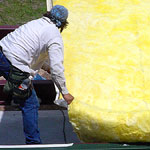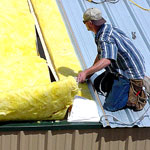Determining the Thickness Required
|
 |
 |
EXAMPLE -
Location of Building: St. Louis
System Type: New
Analysis Type: Heating and Cooling
Incremental Heat Costs: $.64
Incremental Cooling Costs: $.09 |
System U-Value Performance and Installed Cost |
|
| U Value |
Insulation Cost ($/100 s.f.) |
Protected FirstYear After TAX Energy Savings |
Annual Owing Cost ($/100 s.f.) |
Discounted Pay-Back Period |
Net Present Value ($/100 s.f.) |
U Value |
System Cost ($/100 s.f.) |
| 0.08 |
85 |
78.26 |
24.63 |
0.2 |
1781.25 |
0.08 |
85 |
| 0.07 |
90 |
78.91 |
23.11 |
0.2 |
1796.10 |
0.07 |
90 |
| 0.05 |
100 |
80.22 |
20.07 |
0.2 |
1825.78 |
0.05 |
100 |
| 0.03 |
150 |
81.52 |
21.03 |
0.3 |
1855.47 |
0.03 |
150 |
|
Thickness is the key to effective insulation. In order to avoid over or under insulating, it is important to determine the most effective thickness, or "economic thickness," for a particular building.
|
Based on the maximum energy use permitted, "economic thickness" is a function of the building's U-Value. The economic thickness can be determined by taking the following factors into consideration: |
- Energy costs
- Climate (winter and summer)
- Building end use
- Costs of purchasing and maintaining climate control equipment
- Insulation installation costs
- Finance costs (insulation installation and climate control equipment)
|
To analyze these factors, we employ a NAIMA computer program called ESP, which computes the economic U-Value from a list of U-Values based on a minimal amount of data, such as the following: |
- Location of the building (by zip code)
- New or retrofit
- Roof, wall or both
- Heating and cooling costs (heating only or heating and cooling)
- Incremental heating costs (dollars/1, 000 BTU)
- Incremental cooling costs (dollars/KWH)
- Installation cost of metal building systems
|
Example |
| In this example, the economic U-Value is 0.05 due to the fact that it is so inexpensive to maintain. As you can see from these figures, when it comes to insulation, cutting corners at the start only ends up costing more money later. |